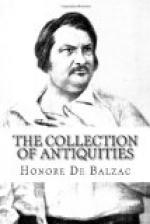He waved his hand toward the castle, mounted his horse, and rode back beside his sister, who had driven over in the notary’s shabby basket-chaise.
The Hotel d’Esgrignon in the town had been demolished; a couple of factories now stood on the site of the aristocrat’s house. So Maitre Chesnel spent the Marquis’ last bag of louis on the purchase of the old-fashioned building in the square, with its gables, weather-vane, turret, and dovecote. Once it had been the courthouse of the bailiwick, and subsequently the presidial; it had belonged to the d’Esgrignons from generation to generation; and now, in consideration of five hundred louis d’or, the present owner made it over with the title given by the Nation to its rightful lord. And so, half in jest, half in earnest, the old house was christened the Hotel d’Esgrignon.
In 1800 little or no difficulty was made over erasing names from the fatal list, and some few emigres began to return. Among the very first nobles to come back to the old town were the Baron de Nouastre and his daughter. They were completely ruined. M. d’Esgrignon generously offered them the shelter of his roof; and in his house, two months later, the Baron died, worn out with grief. The Nouastres came of the best blood in the province; Mlle. de Nouastre was a girl of two-and-twenty; the Marquis d’Esgrignon married her to continue his line. But she died in childbirth, a victim to the unskilfulness of her physician, leaving, most fortunately, a son to bear the name of the d’Esgrignons. The old Marquis—he was but fifty-three, but adversity and sharp distress had added months to every year—the poor old Marquis saw the death of the loveliest of human creatures, a noble woman in whom the charm of the feminine figures of the sixteenth century lived again, a charm now lost save to men’s imaginations. With her death the joy died out of his old age. It was one of those terrible shocks which reverberate through every moment of the years that follow. For a few moments he stood beside the bed where his wife lay, with her hands folded like a saint, then he kissed her on the forehead, turned away, drew out his watch, broke the mainspring, and hung it up beside the hearth. It was eleven o’clock in the morning.
“Mlle. d’Esgrignon,” he said, “let us pray God that this hour may not prove fatal yet again to our house. My uncle the archbishop was murdered at this hour; at this hour also my father died——”
He knelt down beside the bed and buried his face in the coverlet; his sister did the same, in another moment they both rose to their feet. Mlle. d’Esgrignon burst into tears; but the old Marquis looked with dry eyes at the child, round the room, and again on his dead wife. To the stubbornness of the Frank he united the fortitude of a Christian.




